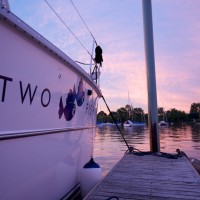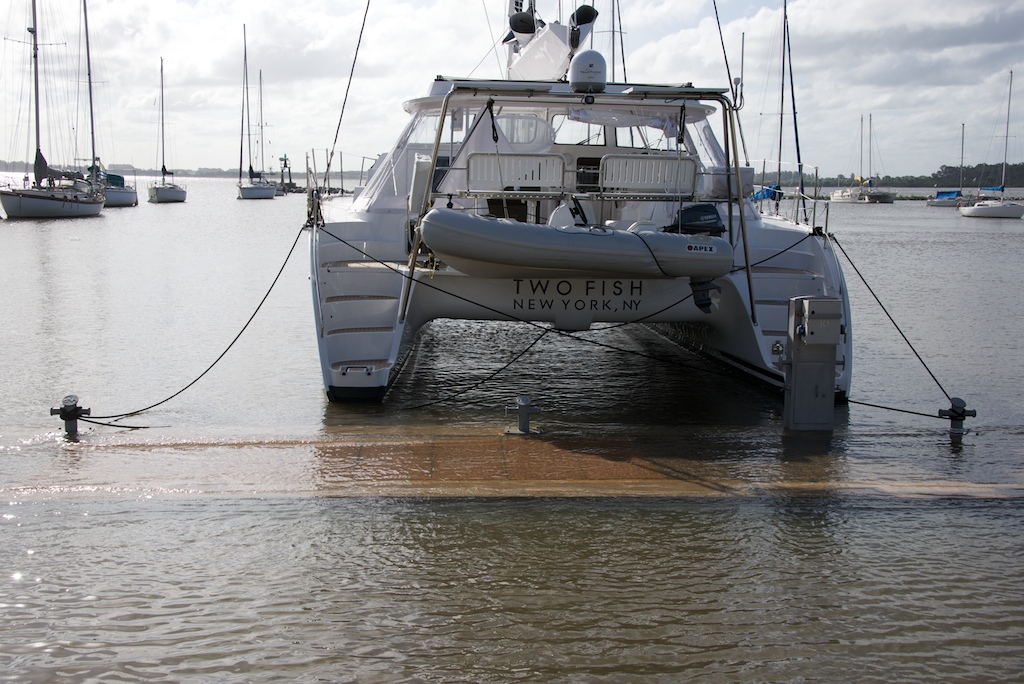The killer app for boats would be an ability to shift into park like a car. Instead, one employs many lines, anchors, mooring balls and more to hold the boat in place when in a harbor. On our cruise, we tried a variety of methods for putting the boat in park after the sailing day ended.
First, life at a dock is a cake walk. You attach the bow/stern lines to dock cleats, add a few spring lines for good measure and adjust your fenders. Expect to lose sleep only when your neighbors’ late salsa music wakes you.
The next level up is a mooring ball. This is an easy move in the BVIs where the balls are serviced regularly and have a friendly pennant line to make attaching to the ball a breeze. In Uruguay, the balls lack the pennant line and are also impossibly heavy to lift, so we used a modified strategy. Rather than grab the mooring ball from the bow, I maneuvered the boat so that the mooring ball was near the stern steps and Gail gracefully attached a long line which could then be walked to the bow. We hopped in the dinghy to attach to a second line to make a bridle. This was also stress free – until 2 am when the tide ran out of energy to flood and switched to ebb. This was when we realized that the mooring balls were not spaced properly for a 44 foot boat. This news did not arrive via a friendly email but by a gentle thumping noise. As I am a new boat owner, I leapt out of my skin and raced on deck to check on what was left of my stern. Not even a scratch. Gail used the boat hook to joust with the mooring ball from the boat from 2 to 3am until she was releaved of duty by a change in the wind. The sailboat companies do not list those early wake ups in the advertisements.
Anchoring is a topic about which volumes have been written. Ask four sailors how to anchor and you will get 5 opinions. Dropping and raising anchor has become much more civilized since the time of Nelson. As long as your thumb is in decent shape, you should be able to press the up button on the windlass and from the depths will come pounds of chain, an anchor and sometimes unwanted mud. No octopuses or treasure chests have come aboard Two Fish, yet. The anchor can be raised from the bow or from the helm.
Where the fun really started for Two Fish was the Mediterranean moor. A Med moor is like tight mens’ swimsuits – a European convention that the US has not embraced. The boat crew drops the anchor and then reverses towards the sea wall, where stern lines are attached. The result is that you can hop from your stern to the shore and buy a fresh baguette. The sailing brochures fail to mention that this type of mooring can raise your heart rate when there is a crosswind and the marina staff are watching you as if it is the Sud America Football Cup. Med mooring with a cross wind is like parallel parking a car except the spot is moving slowly away from you. What is moving seemingly quickly towards you is another boat or, in my case, a metal barge. Like most things in life, there is a trick to make Med moors easy. Just drop the anchor upwind of your desired position on the seawall and the cross wind will put you in the correct spot. The process for leaving a Med moor is to quickly lift anchor before contacting your neighbors. Again a trick can help. BUY VERY LONG DOCK LINES. 250 feet is a great line since you can go forward and raise your anchor while your stern is still attached. Ah, Mr Crosswind I have defeated you again.
The next day, the mooring gods came up with a new trick. The marina staff came by moments before our departure and dropped their maintenance vessel’s anchor and chain on top of our long and heavy anchor chain. We waited patiently so as to be good guests. The staff then realized their mistake and tried to rectify the error. This is when Keystone Cops began. The marina staff dinghy had a 6 hp engine. Not enough power to pull two kegs but the determined dock worker had a plan to execute, even if the laws of physics were against him. Newton be damned. His plan was to use sheer arm strength to lift our strongly-set 75 pound anchor from the muddy harbor bottom. Finally, he realized the futility of his mission and decided to duck their 3 pound anchor under our chain. We were free to go.
Putting the boat in park is always an adventure. Just think of this the next time you park your car at the mall.



One Response to Putting a Boat in Park